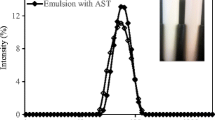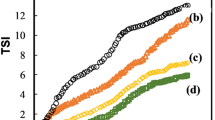ABSTRACT
Beta-carotene is important for fortification of nutritional products while its application is limited by instability. The influence of maltodextrin (MDX) on physicochemical properties and stability of beta-carotene emulsions stabilized by sodium caseinate (SC) was investigated. The emulsions were characterized by dynamic light scattering (DLS), laser diffraction (LD), transmission electron microscopy (TEM), rheometer, and turbiscan lab expert. The effects of pH, ionic strength, and freeze-thaw on stability of emulsions were observed. The emulsions could tolerate up to 2 mol/L NaCl or 10 mmol/L CaCl2 and showed Newtonian behavior. The droplet diameter, polydispersity index, and zeta-potential did not change obviously after 3 months storage at 4°C in dark conditions. The emulsions with MDX showed excellent freeze-thaw stability and gave favorite protection for beta-carotene. The retention ratio of beta-carotene in the emulsions with MDX was above 92.1% after 3 months storage while that in the one without MDX was only 62.7%. The study may provide a promising strategy to improve stability of sensitive nutraceuticals without adding synthetic antioxidants. The findings obtained could provide fundamental basis for rational design of emulsion delivery systems when freeze-thawing is required during manufacturing process or storage period.









Similar content being viewed by others
REFERENCES
Acosta E. Bioavailability of nanoparticles in nutrient and nutraceutical delivery. Curr Opin Colloid Interface Sci. 2009;14(1):3–15. doi:10.1016/j.cocis.2008.01.002.
Palozza P, Muzzalupo R, Trombino S, Valdannini A, Picci N. Solubilization and stabilization of β-carotene in niosomes: delivery to cultured cells. Chem Phys Lipids. 2006;139(1):32–42. doi:10.1016/j.chemphyslip.2005.09.004.
Boon CS, McClements DJ, Weiss J, Decker EA. Factors influencing the chemical stability of carotenoids in foods. Crit Rev Food Sci Nutr. 2010;50(6):515–32.
Brennan C, Brennan M, Derbyshire E, Tiwari BK. Effects of extrusion on the polyphenols, vitamins and antioxidant activity of foods. Trends Food Sci Technol. 2011;22(10):570–5.
Deming DM, Erdman JW. Mammalian carotenoid absorption and metabolism. Pure Appl Chem. 1999;71(12):2213–23.
Faulks RM, Southon S. Challenges to understanding and measuring carotenoid bioavailability. Biochim Biophys Acta (BBA) Mol Basis Dis. 2005;1740(2):95–100. doi:10.1016/j.bbadis.2004.11.012.
Hornero-Méndez D, Mínguez-Mosquera MI. Bioaccessibility of carotenes from carrots: effect of cooking and addition of oil. Innovative Food Sci Emerg Technol. 2007;8(3):407–12. doi:10.1016/j.ifset.2007.03.014.
Mao Y, Dubot M, Xiao H, McClements DJ. Interfacial engineering using mixed protein systems: emulsion-based delivery systems for encapsulation and stabilization of beta-carotene. J Agric Food Chem. 2013;61(21):5163–9. doi:10.1021/jf401350t.
Ribeiro HS, Guerrero JM, Briviba K, Rechkemmer G, Schuchmann HP, Schubert H. Cellular uptake of carotenoid-loaded oil-in-water emulsions in colon carcinoma cells in vitro. J Agric Food Chem. 2006;54(25):9366–9.
Windhab EJ, Dressler M, Feigl K, Fischer P, Megias-Alguacil D. Emulsion processing—from single-drop deformation to design of complex processes and products. Chem Eng Sci. 2005;60(8–9):2101–13. doi:10.1016/j.ces.2004.12.003.
Perrechil FA, Cunha RL. Oil-in-water emulsions stabilized by sodium caseinate: influence of pH, high-pressure homogenization and locust bean gum addition. J Food Eng. 2010;97(4):441–8. doi:10.1016/j.jfoodeng.2009.10.041.
Mao L, Xu D, Yang J, Yuan F, Gao Y, Zhao J. Effects of small and large molecule emulsifiers on the characteristics of b-carotene nanoemulsions prepared by high pressure homogenization. Food Technol Biotechnol. 2009;47(3):336–42.
Roohinejad S, Oey I, Wen J, Lee SJ, Everett DW, Burritt DJ. Formulation of oil-in-water beta-carotene microemulsions: effect of oil type and fatty acid chain length. Food Chem. 2015;174:270–8. doi:10.1016/j.foodchem.2014.11.056.
Liang R, Shoemaker CF, Yang X, Zhong F, Huang Q. Stability and bioaccessibility of β-carotene in nanoemulsions stabilized by modified starches. J Agric Food Chem. 2013;61(6):1249–57.
Li Y, Zheng J, Xiao H, McClements DJ. Nanoemulsion-based delivery systems for poorly water-soluble bioactive compounds: influence of formulation parameters on polymethoxyflavone crystallization. Food Hydrocoll. 2012;27(2):517–28. doi:10.1016/j.foodhyd.2011.08.017.
Ji J, Zhang J, Chen J, Wang Y, Dong N, Hu C, et al. Preparation and stabilization of emulsions stabilized by mixed sodium caseinate and soy protein isolate. Food Hydrocoll. 2015;51(0):156–65. doi:10.1016/j.foodhyd.2015.05.013.
Gutiérrez FJ, Albillos SM, Casas-Sanz E, Cruz Z, García-Estrada C, García-Guerra A, et al. Methods for the nanoencapsulation of β-carotene in the food sector. Trends Food Sci Technol. 2013;32(2):73–83. doi:10.1016/j.tifs.2013.05.007.
Neirynck N, Van lent K, Dewettinck K, Van der Meeren P. Influence of pH and biopolymer ratio on sodium caseinate−guar gum interactions in aqueous solutions and in O/W emulsions. Food Hydrocoll. 2007;21(5–6):862–9. doi:10.1016/j.foodhyd.2006.10.003.
Dickinson E. Hydrocolloids at interfaces and the influence on the properties of dispersed systems. Food Hydrocoll. 2003;17(1):25–39. doi:10.1016/S0268-005X(01)00120-5.
Qian C, Decker EA, Xiao H, McClements DJ. Physical and chemical stability of β-carotene-enriched nanoemulsions: influence of pH, ionic strength, temperature, and emulsifier type. Food Chem. 2012;132(3):1221–9. doi:10.1016/j.foodchem.2011.11.091.
Yuan Y, Gao Y, Zhao J, Mao L. Characterization and stability evaluation of β-carotene nanoemulsions prepared by high pressure homogenization under various emulsifying conditions. Food Res Int. 2008;41(1):61–8. doi:10.1016/j.foodres.2007.09.006.
Sahoo NG, Kakran M, Shaal LA, Li L, Muller RH, Pal M, et al. Preparation and characterization of quercetin nanocrystals. J Pharm Sci. 2011;100(6):2379–90. doi:10.1002/jps.22446.
Qian C, McClements DJ. Formation of nanoemulsions stabilized by model food-grade emulsifiers using high-pressure homogenization: factors affecting particle size. Food Hydrocoll. 2011;25(5):1000–8. doi:10.1016/j.foodhyd.2010.09.017.
Álvarez Cerimedo MS, Iriart CH, Candal RJ, Herrera ML. Stability of emulsions formulated with high concentrations of sodium caseinate and trehalose. Food Res Int. 2010;43(5):1482–93. doi:10.1016/j.foodres.2010.04.008.
Lee L, Norton IT. Comparing droplet breakup for a high-pressure valve homogeniser and a microfluidizer for the potential production of food-grade nanoemulsions. J Food Eng. 2013;114(2):158–63. doi:10.1016/j.jfoodeng.2012.08.009.
Cornacchia L, Roos YH. Stability of beta-carotene in protein-stabilized oil-in-water delivery systems. J Agric Food Chem. 2011;59(13):7013–20. doi:10.1021/jf200841k.
Mitri K, Shegokar R, Gohla S, Anselmi C, Müller RH. Lutein nanocrystals as antioxidant formulation for oral and dermal delivery. Int J Pharm. 2011;420(1):141–6. doi:10.1016/j.ijpharm.2011.08.026.
Klinkesorn U, Sophanodora P, Chinachoti P, McClements DJ. Stability and rheology of corn oil-in-water emulsions containing maltodextrin. Food Res Int. 2004;37(9):851–9. doi:10.1016/j.foodres.2004.05.001.
Dokic-Baucal L, Dokic P, Jakovljevic J. Influence of different maltodextrins on properties of O/W emulsions. Food Hydrocoll. 2004;18(2):233–9. doi:10.1016/s0268-005x(03)00068-7.
Surh J, Decker EA, McClements DJ. Influence of pH and pectin type on properties and stability of sodium-caseinate stabilized oil-in-water emulsions. Food Hydrocoll. 2006;20(5):607–18.
Sosa-Herrera MG, Lozano-Esquivel IE, Ponce de León-Ramírez YR, Martínez-Padilla LP. Effect of added calcium chloride on the physicochemical and rheological properties of aqueous mixtures of sodium caseinate/sodium alginate and respective oil-in-water emulsions. Food Hydrocoll. 2012;29(1):175–84. doi:10.1016/j.foodhyd.2012.02.017.
Liang Y, Gillies G, Patel H, Matia-Merino L, Ye A, Golding M. Physical stability, microstructure and rheology of sodium caseinate-stabilized emulsions as influenced by protein concentration and non-adsorbing polysaccharides. Food Hydrocoll. 2014;36(0):245–55. doi:10.1016/j.foodhyd.2013.10.006.
Kayes J. Pharmaceutical suspensions: relation between zeta potential, sedimentation volume and suspension stability. J Pharm Pharmacol. 1977;29(1):199–204.
Mao L, Roos YH, Miao S. Effect of maltodextrins on the stability and release of volatile compounds of oil-in-water emulsions subjected to freeze–thaw treatment. Food Hydrocoll. 2015;50:219–27. doi:10.1016/j.foodhyd.2015.04.014.
Thanasukarn P, Pongsawatmanit R, McClements D. Influence of emulsifier type on freeze-thaw stability of hydrogenated palm oil-in-water emulsions. Food Hydrocoll. 2004;18(6):1033–43.
Fioramonti SA, Arzeni C, Pilosof AMR, Rubiolo AC, Santiago LG. Influence of freezing temperature and maltodextrin concentration on stability of linseed oil-in-water multilayer emulsions. J Food Eng. 2015;156:31–8. doi:10.1016/j.jfoodeng.2015.01.013.
Dickinson E, Galazka VB. Emulsion stabilization by ionic and covalent complexes of β-lactoglobulin with polysaccharides. Food Hydrocoll. 1991;5(3):281–96.
ACKNOWLEDGMENTS
This research was supported by the following project. Authors gratefully thank College of Chemistry and Chemical Engineering, South China University of Technology, for providing the use of Turbiscan Lab Expert (Formulaction, France). This work was supported by National High-tech R&D Program, namely the 863 Program (No. 2014AA022205), and supported by Science and Technology Foundation Guangzhou, namely “Public Research Platform for Production Technology for Novel Pharmaceutical Formulations” (No. 201509030006).
Author information
Authors and Affiliations
Corresponding author
Rights and permissions
About this article
Cite this article
Zhang, J., Zhang, X., Wang, X. et al. The Influence of Maltodextrin on the Physicochemical Properties and Stabilization of Beta-carotene Emulsions. AAPS PharmSciTech 18, 821–828 (2017). https://doi.org/10.1208/s12249-016-0572-5
Received:
Accepted:
Published:
Issue Date:
DOI: https://doi.org/10.1208/s12249-016-0572-5




